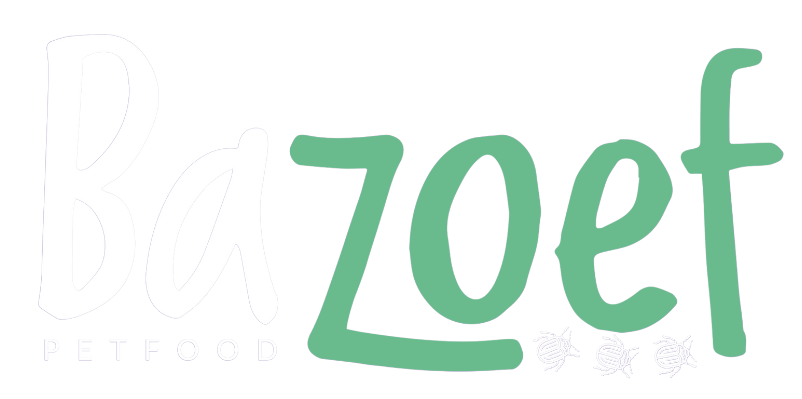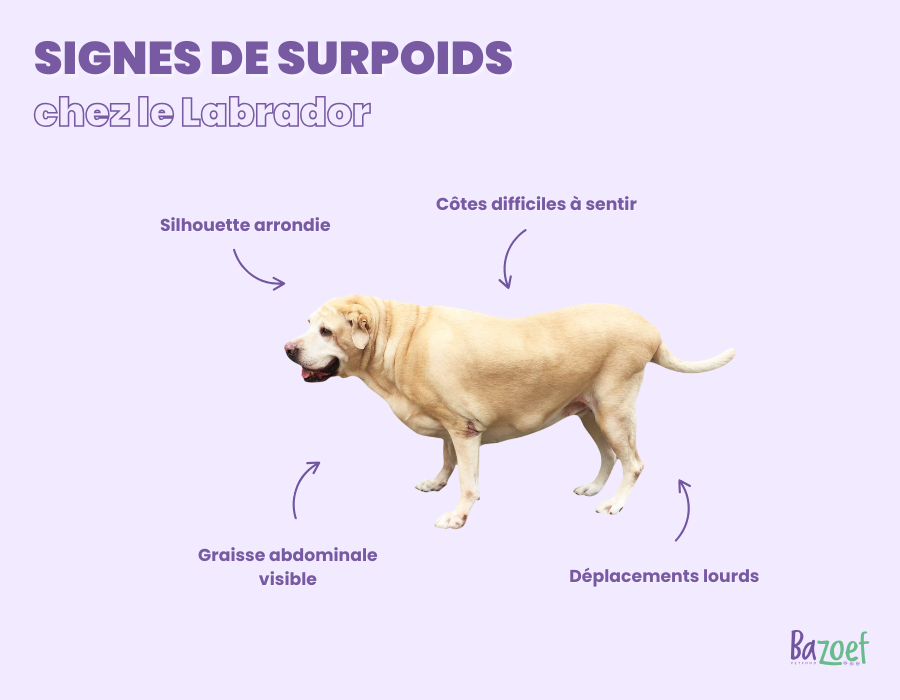With their gentle eyes and boundless appetite, Labradors are truly endearing companions — but they’re also one of the breeds most prone to gaining weight.
Their genetic tendency to store fat, coupled with a strong love of food, makes them particularly susceptible to putting on extra pounds, sometimes even from a young age.
But weight gain isn’t inevitable.
To help keep a Labrador at a healthy weight, it’s essential to carefully manage their food portions, keep treats to a minimum, and ensure they get daily exercise. A high-quality diet tailored to their ideal weight, combined with regular walks, is often all it takes to keep them in shape.
This article breaks it all down for you!

Is My Labrador Overweight?
Weight alone isn’t enough to tell — a Labrador can be heavy simply because it’s very muscular.
To properly assess your dog’s body condition, you need to look at a combination of simple visual and hands-on signs that you can easily check at home.
The Body Condition Score (BCS) — known in French as Indice de Condition Corporelle (ICC) — is a visual and tactile method used by vets to determine whether a dog is underweight, overweight, or in ideal shape.
For Labradors, a breed particularly prone to putting on extra pounds, this is an essential reference to check regularly.
📊 Below is a table showing the BCS scale and how to interpret it:
| BCS Score | Body Condition | Description for Labradors |
| 1-2 | Severely underweight | Ribs and spine very prominent, muscle loss, no detectable fat |
| 3 | Underweight | Visible ribs, very tucked waist, little muscle mass |
| 4-5 ✅ | Ideal weight | Ribs easily felt under a thin fat layer, well-defined waist, slight tuck in abdomen |
| 6 | Slightly overweight | Light fat cover over ribs, waist less obvious |
| 7 | Overweight | Ribs hard to feel, belly sagging, rounded shape |
| 8 | Significantly overweight | Noticeable abdominal fat, no visible waist |
| 9 | Severely obese | Overall heavy fat deposits, difficulty moving, frequent shortness of breath |
How to assess your Labrador’s BCS at home:
- Feel the ribs: they should be easily felt under a thin layer of fat.
- Look from above: you should see a slight waist behind the ribs (an hourglass shape).
- View from the side: the belly should tuck up slightly, not be level with the chest.
- Check the base of the tail and shoulders: there shouldn’t be any obvious fat rolls or soft masses.
👉 A BCS of 4 or 5 is ideal for an adult Labrador.
At a score of 6, you should start adjusting diet and exercise.
At 7 or above, it’s strongly recommended to seek veterinary guidance.

How Much Should My Labrador Weigh?
A Labrador’s weight naturally changes as it grows, before leveling off in adulthood.
Keeping a close eye on their weight from an early age helps prevent excess pounds — especially important for this breed, which is prone to gaining weight.
Monitoring their weight over time is key to avoiding joint issues, metabolic problems, and other obesity-related diseases.
📊 Here’s a guideline table showing average weights at key life stages for male and female Labradors:
| Age | Average Weight Male | Average Weight Female |
| 2 months | 6 – 8 kg | 5 – 7 kg |
| 4 months | 11 – 14 kg | 10 – 13 kg |
| 6 months | 18 – 23 kg | 16 – 21 kg |
| 9 months | 24 – 28 kg | 22 – 26 kg |
| 12 months (1 yr) | 28 – 33 kg | 25 – 30 kg |
| 18 months (adult) | 30 – 36 kg | 26 – 32 kg |
| Senior (7+ yrs) | Variable (maintain healthy shape) | Same |
These figures are averages; the most important is to maintain your Labrador’s weight in line with their build and body condition.
🔎 Note: These values are only guidelines and can vary depending on the dog’s lineage (working or show lines), activity level, and individual build.
What matters most is your Labrador’s overall body condition (see “Body Condition Score”), not a specific number on the scale.
Tips to Prevent Your Labrador from Becoming Overweight
1. Adjust portions to their ideal weight
Serve the amount of food that matches your Labrador’s target healthy weight, not their current weight if they’re already overweight.
Use a kitchen scale (instead of a measuring cup, which is often inaccurate) to avoid unintentionally overfeeding.
2. Split meals
Divide the daily food allowance into two meals (morning and evening). This helps with digestion and prevents blood sugar spikes.
If your dog tends to gulp down food, use a slow-feeder bowl or hide portions in a snuffle mat to make eating take longer.
3. Avoid table scraps
Foods like cheese, bread, or cured meats are far too high in fat and salt for your dog.
For example, a single piece of pizza or cheese is roughly the canine equivalent of a full fast-food meal for a human! It’s best to avoid giving anything at the table to prevent bad habits.
4. Choose healthy treats
Swap fatty treats for steamed veggies (like zucchini, carrots, green beans) or low-calorie dog snacks.
A few slices of zucchini or a thin piece of apple (without seeds) are enough to reward your dog without adding extra pounds. Just remember to count these in the total daily calories.
5. Keep them active
A Labrador needs at least 1 hour of moderate exercise daily. This could be a brisk 30-minute walk plus 20 minutes of fetch in the yard.
Swimming in a lake or river is also fantastic for burning calories while being gentle on the joints — especially in summer. If you’re short on time, try mental stimulation games or scent work indoors.

Examples of Healthy Foods for Labradors
Feeding your Labrador a balanced diet starts with choosing ingredients that are easy to digest, filling, and rich in essential nutrients.
Some foods, like insect proteins or hull-less oats, offer excellent nutritional value while helping keep weight in check.
For a complete overview of your Labrador’s dietary needs, we recommend reading our full Labrador feeding guide.
📊 Here’s a table with practical examples, including a complete, healthy recipe idea to feed your dog without overdoing it or causing deficiencies:
| Ingredient | Nutritional Benefits |
| Insect protein | Rich in essential amino acids, hypoallergenic, highly digestible, low in fat |
| Hull-less oats | Whole grain, high in soluble fiber, filling, low glycemic index |
| White rice | Easily digestible energy source, gentle on sensitive stomachs |
| Peas | Plant protein, fiber, supports healthy digestion |
| Rapeseed (canola) oil | Omega-3 & 6, promotes healthy skin, coat, and heart function |
| Dried pumpkin | High in gentle fiber, aids digestion and regularity |
| Dried chicory root | Natural prebiotic (inulin), supports a healthy gut flora |
| Brewer’s yeast, yeast extract | Source of B vitamins, boosts coat health and immunity |
| MOS (prebiotics) | Supports immune and gut health, helps limit harmful bacteria |
| Dried carrots | Rich in beta-carotene (vitamin A), natural antioxidant |
| Dried apples | Provides fiber and natural sugars (quick energy without excess) |
| Cranberries | Antioxidant, supports urinary health, naturally low in sugar |
If you’d like, I can also translate or adapt a sample recipe using these ingredients for your Labrador. Let me know!
This recipe is especially well-suited for Labradors that are overweight or have sensitive digestion, as it avoids excess fats, includes filling fibers, and uses highly digestible alternative proteins.

It can be served as a complete meal or used as part of a transition toward a more natural or targeted diet (digestive support, weight management, hypoallergenic).
Consequences of Overweight in Labradors
Being overweight isn’t just about looks — for Labradors, it can lead to serious, long-lasting health issues.
Here are the main risks to be aware of:
1. Early joint problems
Excess weight puts extra stress on the hips, elbows, and knees. This promotes the development of dysplasia, arthritis, or chronic lameness — all especially common in this breed.
2. Shortness of breath and exercise intolerance
An overweight Labrador tires more quickly and may struggle to breathe after even a short walk. This reduces their desire to move… creating a vicious cycle of inactivity.
3. Higher metabolic risks
Being overweight raises the chances of developing diabetes, hormonal disorders (like hypothyroidism), or heart problems — conditions that may require lifelong treatment.
4. Shortened lifespan
Studies show that an overweight dog can live up to 2 years less than a dog at a healthy weight, with poorer quality of life (pain, low energy, costly medical care).
5. Weaker immune system and inflammation
Excess body fat fuels chronic inflammation, which weakens the dog’s immune defenses and makes them more susceptible to infections, allergies, or post-surgery complications.

Simple Activities to Help Your Labrador Burn Calories
Labradors love being active, but without enough stimulation, they can quickly become couch potatoes.
To prevent weight gain (or help with weight loss), it’s essential to offer regular, varied activities suited to their age and condition.
There’s no need to run a marathon — even short, well-chosen daily sessions make a real difference.
📊 Table: Fun, calorie-burning activities for Labradors
| Activity | Suggested Duration | Benefits |
| Brisk walking | 30–60 min/day | Gentle calorie burn, endurance, strengthens your bond |
| Fetch games | 15–20 min | Cardio, instant fun, engages retrieving instinct |
| Swimming (lake/river) | 10–30 min | Great for joints, burns lots of energy, perfect in summer |
| Home/yard obstacle play | 10–15 min | Agility, coordination, mental stimulation with simple setups |
| Snuffle mat / scent games | 10 min | Calm focus, mental fatigue, helps curb boredom snacking |
| Easy jogging on leash | 20 min | Shared activity, improves cardio and pacing |
💡 Tip: Even 3 × 10 minutes of active play a day is better than one long walk once a week. The key is consistency.
Conclusion
Feeding your Labrador properly is about so much more than just filling their bowl: it’s a daily commitment to their health, mobility, longevity — and happiness.
Affectionate but prone to weight gain, Labradors need a balanced diet, regular weight checks, and daily exercise.
Whether you choose insect-based kibble, a well-formulated home-cooked diet, or a mixed approach, the essentials remain the same: quality, moderation, and consistency.
By keeping an eye on their appetite, energy, body condition, and digestion, you’ll give your companion the best chance at a long, healthy life by your side.
And remember: the best diet is the one that suits your Labrador — not necessarily what works for every dog!
Sources:
- FEDIAF – European Pet Food Industry Nutritional Guidelines
- AAFCO – Association of American Feed Control Officials




